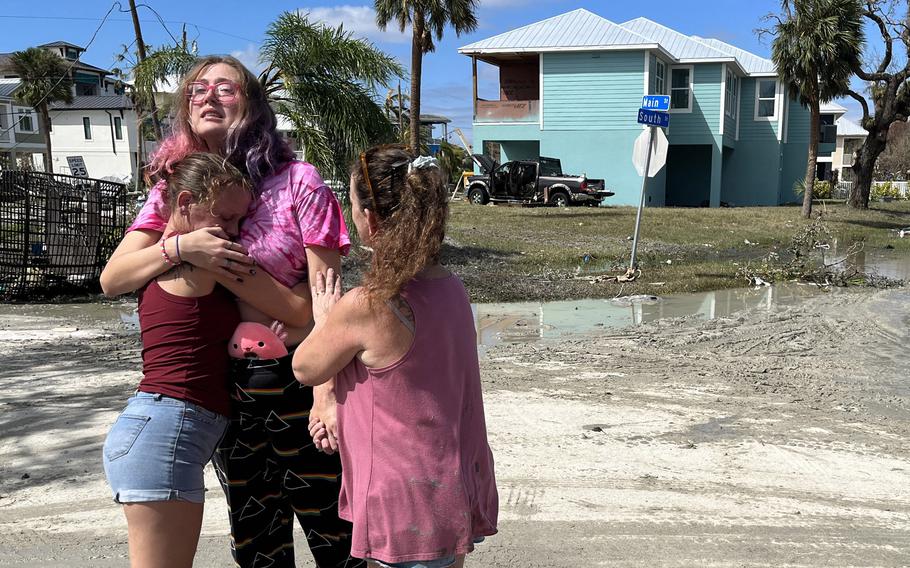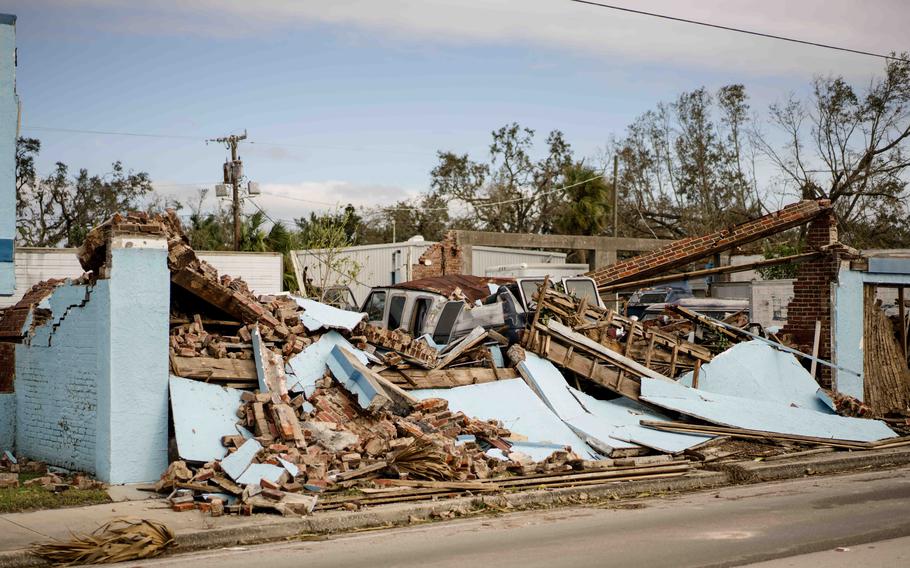U.S.
Searchers hunt for victims of Hurricane Ian amid a swath of destruction
The Washington Post September 30, 2022

Kristelle Reed comforts Courtney Schneider after they discovered what they lost in Fort Myers Beach, Fla., on Thursday, Sept. 29, 2022. Reed said her apartment in Fort Myers Beach had flooded, killing her pet fish. Schneider watched her car float away in the storm surge. (Molly Hennessy-Fiske/The Washington Post)
Emergency crews and search teams deployed across the Ian-battered flood zones of Southwest Florida on Thursday, hunting for survivors and the missing while only beginning to measure the massive scope of destruction wrought the day before by one of the most powerful hurricanes ever to hit the United States.
More than 2.5 million Floridians remained without power in a region where a three-pronged punch of storm surge, fearsome winds and downpours inundated roads, flipped boats, unmoored houses from their foundations and destroyed at least two bridges to barrier islands.
Yet even as the Gulf Coast emerged from more than a day of harrowing weather, Ian made clear it was not yet finished. Early Friday, weakened to a tropical storm, it dumped record-setting rain on what officials predicted would be a deadly and costly path across the peninsula. Then it moved offshore into the Atlantic, where it strengthened again into a hurricane. It is expected to slam into South Carolina on Friday.
Flooding across a wide swath of Florida’s hard-hit coastal counties made rescue missions slow and challenging, officials said, offering widely varying estimates of a death toll. Lee County Sheriff Carmine Marceno said early Thursday that “hundreds” may have lost their lives to the wrath of Hurricane Ian, which made landfall as a Category 4 storm. Later, Florida Gov. Ron DeSantis (R) said two people had been confirmed dead, and it was not yet clear whether the storm was to blame. President Biden, who declared the state a major disaster area, warned of “substantial loss of life.”
The U.S. Coast Guard and Urban Search and Rescue Teams, joined by 28 large helicopters, were performing “active rescue missions,” particularly near the barrier islands that surround Florida’s southwestern coast, DeSantis said. Whatever the casualties, he said, Ian’s damage appeared “historic” and its legacy immense.
“You’re looking at a storm that’s changed the character of a significant part of our state,” DeSantis said Thursday morning in Tallahassee. “This is going to require not just the emergency response now, and the days or weeks ahead, I mean, this is going to require years of effort, to be able to rebuild, to come back.”
By midafternoon Thursday, more than 500 people had been rescued in Charlotte and Lee counties since operations began in the morning, the Florida Division of Emergency Management said.

Flooding and storm damage after Hurricane Ian ravaged Fort Myers, Fla. (Thomas Simonetti/The Washington Post)
Residents who witnessed the hurricane’s fury and its aftermath described terrifying scenes.
Bill D’Antuono, a charter boat captain, was at his aunt and uncle’s canal-front house in Naples Park when the water, he said, started rising “real fast.” Ten minutes later, a foot of water had surged into the house. Eventually, it rose above the kitchen countertops. The three fled to the second floor.
On Thursday, the lifelong Naples resident emerged into a transformed city, with boats in roadways, streets underwater and homes filled with water. The landmark Naples Pier was torn apart in some sections. D’Antuono, 36, said his house in the Bayshore area appeared flooded beyond repair.
“Everything we knew is different now,” he said.
D’Antuono was in an evacuation zone but didn’t leave, in part because an earlier predicted track for Ian had the storm headed to Tampa, significantly north of his home. His family had emerged unscathed from many storms and scares in the past, he said. But Ian was not like those other times.
“This is unbelievable,” he said. “I mean it’s just - it’s truly a nightmare. It’s something that I wouldn’t wish on anyone. And it just happened to every single person I know.”
Far from the bludgeoned southwest coast, Ian was still making its mark, unloading 10 to 20 inches of rain across a wide belt of Florida. Orlando, in central Florida, set a 24-hour rainfall record with 12.49 inches through 8 a.m. — roughly twice its monthly average. Overnight Wednesday, nearly 17 inches of rain fell near the city, where the storm had forced Walt Disney World to shutter. (The theme park was set to reopen Friday.)
On the Atlantic coast, 28 inches fell in New Smyrna Beach. In St. Augustine, about 30 miles south of Jacksonville, storm surge caused the Matanzas River to overflow, flooding downtown streets. The National Hurricane Center projected a peak surge of up to 4 to 6 feet in the area.
Multiple rivers were at or headed toward record levels. Because the ground was already saturated from rain, Ian’s downpours had an even greater effect, said Rick Davis, a meteorologist with the National Weather Service’s Tampa Bay office.
“The weather is improving for the beaches, but the weather for the people that live by the rivers, they’re going to be impacted for weeks to come with high water,” Davis said.
That was sinking in Thursday for Raj Sukhraj, who had been rescued in the morning with her dog from their home near a lake in West Orlando.
“I never thought it would be this bad,” said Sukhraj, 61, a former schoolteacher who has lived in her house for 10 years. “We went through Hurricane Irma, and it wasn’t anything like this. If I had known, I would have gotten out before it came.”
Sukhraj said she woke up in the middle of the night as Hurricane Ian, by then a Category 1 storm, passed over, and when she put her feet on the floor, the water in her bedroom covered her foot.
“And then it came up to here,” she said, using her cane to measure water that rose up to her shins. “I looked out the window and saw the rescuers across the street, so I opened the window and started yelling and knocking, and they came and got me and my baby.”
In South Carolina, the worst seemed yet to come. The Hurricane Center was projecting a “life-threatening” surge of up to 4 to 7 feet along the central coast, including around Charleston, with hurricane-force winds expected to rake the South Carolina coastline on Friday morning.
But an uncertain forecast meant it was possible Ian could strengthen into a Category 2 hurricane as it moves over the warm waters of the Gulf Stream.
Flooding, both from a dangerous storm surge and heavy rainfall, was also likely in and around Charleston, forecasters said. A “life-threatening” storm surge of 4 to 7 feet was possible within vulnerable areas, and a flood watch was posted with 4 to 8 inches of rain likely, with localized higher amounts. There was an isolated risk of a tornado or two, as well.
In addition to the storm surge and hurricane warnings for South Carolina, tropical storm and surge watches and warnings covered much of the North Carolina, Georgia and central and north Florida coasts.
Back in southwest Florida, residents struggled to make sense of what had become of their relaxed region of white-sand beaches.
Survivors picked through Hurricane Ian’s scattered wreckage at the foot of the bridge leading to Fort Myers Beach — massive tour and shrimp boats run aground, restaurants and trailers ripped open and inundated with gray-brown mud. One boat was lodged in a telephone pole. Another was leaning against a restaurant.
Shrimp captain Leonard Hunte, 77, and his nephew survived by clinging to a piece of Styrofoam that floated by Hunte’s mobile home.
“The water was up there,” Hunte said, pointing to the roof of his RV.
“I held onto that tree for three hours,” said his nephew Shaun Hunte, 55, a part-time shrimper.
Many in the area lost not only homes but jobs. Edward Madden, whose mobile home at Sunnyland Trailer Court near the bridge also flooded, said he’d seen photos that showed the Dairy Queen where he worked was gutted.
“Water’s all in it. There’s not much left,” said Madden, 60.
He circled the RV park, looking for neighbors to help, his neon-green shirt, khaki shorts and sneakers caked with mud. When passing strangers asked how he was, Madden said, “No home no more.”
“You got your life, though,” a man said, and hugged him.
Madden agreed.
“We’ve got our lives,” he said. “That’s the most important thing.”
Down debris-strewn San Carlos Boulevard, recent arrival Daryl Silva was feeling both blessed and cursed.
Silva, 66, a retired UPS worker and U.S. Navy veteran trained in search and rescue, had just moved to the area from Minneapolis two months earlier, bringing several antique cars, motorcycles and a new sedan. All flooded, along with family keepsakes stored with them in a first-floor garage under the apartment where he sheltered during the storm. He estimated his losses at $300,000.
“I’m lucky to be alive. Sad thing is every one of my photos from when I was a child, my mother and father’s urns are in there,” he said as he sat outside near his dock, where two strangers’ boats had lodged during the storm. “People need to know when they tell you to leave, leave. I’m a tough guy. Do you think I got a thing of water? No. I didn’t even get any cash.”
Early Thursday, Silva walked over the bridge to see what remained of Fort Myers Beach — very little, he said.
“Hooters is gone - demolished to the ground. Everything on that beach is gone except the condos,” he said.
In Tampa, which was preparing earlier this week for catastrophic damage, residents and officials remained stunned Thursday by their relative good fortune.
There were scattered reports of downed power lines, felled trees, home damage and electricity outages in the area. But by midmorning, Tampa Bay’s biggest counties had lifted the mandatory evacuation orders that covered millions of residents in the days leading up to Ian’s arrival.
“The damage is minimal in the evacuated areas,” said Timothy Dudley, Hillsborough County’s emergency management director.
Alphonso Poole, who chose to ride out the storm in his bungalow on Harper Street, said storm conditions in the area were “nothing.”
“I walked through the storm and got more coffee,” he said, smiling, as he stood in the front yard of his neighbor’s house. “We’re tough ‘round here, we’ve got to keep life going.”
Hennessy-Fiske, Shammas and Rozsa reported from Florida. Brulliard reported from Boulder, Colo. The Washington Post’s Jason Samenow and Zach Rosenthal in Washington contributed to this report.